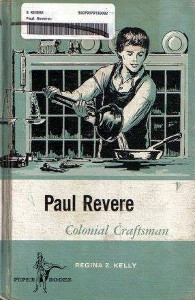Paul Revere: Colonial Craftsman

Author:
Regina Z. Kelly
Illustrator:
Harvey Kidder
Publication:
1963 by Houghton Mifflin Company
Genre:
Biography
Series:
Piper Books ![]() Members Only
Members Only
Current state:
This book has been evaluated and information added. It has not been read and content considerations may not be complete.
Book Guide
Search for this book used on:
Author's Note
There is very little known about the early life of Paul Revere. We do know that he signed a contract to ring the bells of Christ Church, and also that his father beat him for listening to Reverend Mayhew preach. He attended the North Writing School and was apprenticed to his father, and so his boyhood was probably as it is in this story.
Most of us remember Paul Revere because of the poem about his midnight ride written by Henry Wadsworth Longfellow. Mr. Longfellow made several errors in his poem. The true facts are those that are related in this book. They are based on two accounts of his ride written by Paul Revere himself.
Paul Revere is also famous as a silversmith and coppersmith. Many of the beautiful pieces that he made are in museums all over the country, as well as in private homes. Perhaps the finest collection is in the Museum of Fine Arts in Boston. Here you will also see the portrait of Paul Revere painted by Copley and the portraits of Paul and Rachel when they were older, painted by Stuart. There is also a gold-framed miniature of Rachel painted when she was a young woman.
There is little difference in the way silver pieces are made today from the way in which they were made in the time of Revere. However, machinery is used today for molding most of the pieces, and electricity controls the heat. The decorating which is called "chasing" is still done by hand with small tools and punches. Special engraving is also done by hand. The standard of nine and one-fourth parts silver to three-fourth parts copper is still the proportion for sterling silver today.
There are many places in and around Boston to remind us of Paul Revere. The most famous is his North Square house. It has been restored and is furnished as it was in his time. It is the oldest house on Boston. Near it is the Old North Church. It was called Christ Church in Revere's boyhood, but after the Old North meeting house of his time was destroyed during the Revolution, Christ Church was called Old North.
Church services are held regularly in Old North, and the bells that Paul Revere rang are still in the belfry. The window in which Robert Newman hung the lanterns has been bricked up.
Every year on April 18, the lanterns are hung in Old North by a descendant of either Paul Revere or Robert Newman. On the following morning, a man dressed like Paul Revere repeats his famous ride. You can drive over the same route today. Every place Paul Revere passed is plainly marked.
The Town House (now called the Old State House), Faneuil Hall, and the Old South Meeting House have been restored and are now museums. The site of the Boston Massacre is shown in the paving in front of the Old State House. There are plaques to show where the "tea party" took place, and where the Liberty Tree grew. The ship Constitution for which Revere made copper fittings and a copper bottom is now restored and is in the Navy Yard.
If you go to Lexington, you will see the Clark-Hancock house and the green where the first minutemen were killed. In Concord, there is a reproduction of the North Bridge where the British were forced to retreat.
The great Revere Copper and Brass Company of today is descended from the copper-rolling mill at Canton that was started by Paul Revere and his son Joseph Warren. Edward H. Revere, the great-grandson of Paul, was the last member of the family with the Revere name to be a director of the company. He died in 1957.
The Reveres were also important bell casters. They probably made about four hundred bells, many of which are still in use. The largest and most famous of their bells are in King's Chapel in Boston. The first bell made for the Cockerel Church was bought by St. James's Episcopal Church in Cambridge. The church has no bell tower, so the bell is now in the nave.
Regina Z. Kelly
Content Guide
Please sign in to access all of the topics associated with this book and view other books with the same topics.
Please sign in to access the locations this book takes place in and view other books in the same location.
Please sign in to access the time periods this book takes place in and view other books in the same time period.
Resource Guide
Find This Book
Search for this book used on:



